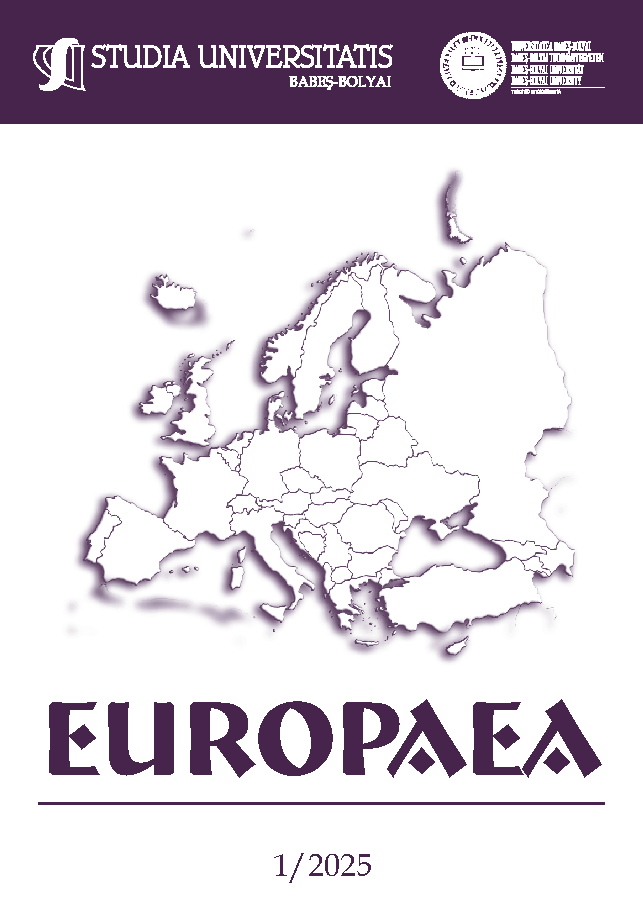New Determinants of the Balance of Power: From Nuclear Power to the Power of New Technologies and The Crucial Debate on Autonomous Weapons Systems
DOI:
https://doi.org/10.24193/subbeuropaea.2025.1.10Keywords:
lethal autonomous weapons systems, balance of power, arms race, LAWS regulationAbstract
This article explores the global debate on lethal autonomous weapons systems (LAWS), highlighting the “technological” arms race, that gradually seems to become a determining factor in establishing a new world order. It further examines the key positions of the USA, China and the Russian Federation on the issue of LAWS regulation and the probable reasons behind them. The paper also analyzes the turning point reached in discussions related to the establishment of a regulatory framework for these technological weapons at the level of UN institutions.
References
1. Bennet, Samuel (2019), “The Development of Artificial Intelligence in Russia”, in Nicholas D. Wright, ed., Artificial Intelligence, China, Russia, and the Global Order, Maxwell, Alabama, Air University Press, 168-177.
2. Bondar, Kateryna (2025), Ukraine’s Future Vision and Current Capabilities for Waging AI-Enabled Autonomous Warfare, Center for Strategic & International Studies (CSIS), [https://www.csis.org/analysis/ukraines-future-vision-and-current-capabilities-waging-ai-enabled-autonomous-warfare].
3. DeepAI, Understanding Narrow AI: Definition, Capabilities, and Applications, [https://deepai.org/machine-learning-glossary-and-terms/narrow-ai].
4. Engstrom, Jeffrey (2018), Systems Confrontation and System Destruction Warfare, RAND Corporation, California.
5. Human Rights Watch, Killer Robots, [https://www.hrw.org/topic/arms/killer-robots].
6. Human Rights Watch (2020), Stopping Killer Robots: Country Positions on Banning Fully Autonomous Weapons and Retaining Human Control, August 10, 2020, [https://www.hrw.org/report/2020/08/10/stopping-killer-robots/country-positions-banning-fully-autonomous-weapons-and].
7. Kissinger, Henry, Schimidt, Eric, Huttenlocher, Daniel (2021), The Age of A.I. and our Human Future, London, John Murray.
8. Kmentt, Alexander (2025), Geopolitics and the Regulation of Autonomous Weapons Systems, Arms Control Association, [https://www.armscontrol.org/act/2025-01/features/geopolitics-and-regulation-autonomous-weapons-systems].
9. Lee, Kai-Fu, AI Super Powers. China, Silicon Valley and The New World Order, Houghton Mifflin Harcourt, New York, 2018.
10. Lipton, Eric (2023), As A.I.-Controlled Killer Drones Become Reality, Nations Debate Limits, The New York Times, November 21, 2023, [https://www.nytimes.com/2023/11/21/us/politics/ai-drones-war-law.html].
11. Mozur, Paul; Satariano, Adam (2024), A.I. Begins Ushering in an Age of Killer Robots, The New York Times, July 2, 2024 [https://www.nytimes.com/2024/07/02/technology/ukraine-war-ai-weapons.html].
12. Russia Today (2017), Whoever leads in AI will rule the world’: Putin to Russian children on Knowledge Day, September 2017 [https://www.rt.com/news/401731-ai-rule-world-putin/].
13. Sayler, Kelley M. (2025), “Defense Primer: U.S. Policy on Lethal Autonomous Weapon Systems”, Congressional Research Service (CRS) Report, February 1, 2025, [https://crsreports.congress.gov/product/pdf/IF/IF11150].
14. UN General Assambly (2023), First Committee Approves New Resolution on Lethal Autonomous Weapons, November 2023, [https://press.un.org/en/2023/gadis3731.doc.htm].
15. UN Office for Disarmament Affairs (UNODA) (2023), Convention on Prohibitions or Restrictions on the Use of Certain Conventional Weapons Which May Be Deemed to Be Excessively Injurious or to Have Indiscriminate Effects, Non-exhaustive Compilation of Definitions and Characterizations [https://docs-library.unoda.org/Convention_on_Certain_Conventional_Weapons_-Group_of_Governmental_Experts_on_Lethal_Autonomous_Weapons_Systems_(2023)/CCW_GGE1_2023_CRP.1_0.pdf].
16. UN Office for Disarmament Affairs (UNODA), Lethal Autonomous Weapon Systems (LAWS) [https://disarmament.unoda.org/the-convention-on-certain-conventional-weapons/background-on-laws-in-the-ccw/].
17. US Departament of Defence (2018), Group of Governmental Experts of the High Contracting Parties to the Convention on Prohibitions or Restrictions on the Use of Certain Conventional Weapons Which May Be Deemed to Be Excessively Injurious or to Have Indiscriminate Effects, Humanitarian Benefits of Emerging Technologies in the Area of Lethal Autonomous Weapon Systems, April 3, 2018, [https://docs-library.unoda.org/Convention_on_Certain_Conventional_Weapons_-_Group_of_Governmental_Experts_(2018)/CCW_GGE.1_2018_WP.4.pdf].
18. Xinhua (2018), China Starts Building Test Site for Unmanned Ships, February 13, 2018, [http://www.xinhuanet.com/english/2018-02/13/c_136972132.htm].
Downloads
Published
How to Cite
Issue
Section
License
Copyright (c) 2025 Studia Universitatis Babeș-Bolyai Studia Europaea

This work is licensed under a Creative Commons Attribution-NonCommercial-NoDerivatives 4.0 International License.



